|
|

This chapter contains a description of the BPX service interface (line) cards, including the ATM Service Interface (ASI) and associated backcards.
This chapter contains the following:
The BPX service interface group of cards provides an ATM interface between the BPX and CPE (Figure 5-1). The ASI series of cards (DS3, E3, and OC3) are described in this chapter. The BXM card service operation is briefly described in this chapter with additional information provided in a later chapter. The BXM cards may be configured for either trunk or port (service access UNI) mode. In service (port UNI) mode they provide ATM service interfaces to CPE.
The BXM card sets supports OC-12/STM-4 or OC-3/STM-1 interfaces, and provide the capacity to meet the needs of emerging bandwidth driven applications. The BXM provides high speed ATM connectivity, flexibility, and scalability. The card sets are comprised of a front card that provides the processing, management, and switching of ATM traffic and of a back card that provides the physical interface for the card set.
A BXM port may be configured to operate as either a trunk or UNI port. The BXM OC-12 back cards support Single Mode Fiber (SMF), Single Mode Fiber Long Reach (SMFLR), or Single Mode Fiber Extra Long Range (SMFXLR). The BXM OC-3 back cards support either Multi-Mode Fiber (MMF), Single Mode Fiber (SMF), or Single Mode Fiber Long Reach (SMFLR).
For a further description of the BXM cards refer to Chapter 6, BXM T3/E3, 155, and 622.

The ATM Service Interface Card for T3 and E3 interfaces (ASI-1) is a front card for use in the BPX to interface an ATM user device e.g., CPE (Customer Premise Equipment). The ASI provides an industry-standard ATM User-to-Network Interface (UNI) or ATM Network-to-Network Interface (NNI) to the BPX switching fabric.
A summary of features for the ASI card include:
Each ASI-1 card provides two ATM UNI/NNI ports, each operating at DS3 rates or E3 rates (Figure 5-2). Any of the 12 general purpose slots can be used to hold these cards. The ASI-1 operates with a corresponding T3 or E3 Line Module back card LM-2T3 or LM-2E3, respectively. Only the first two connectors on the back card are active; the lower port is not used.
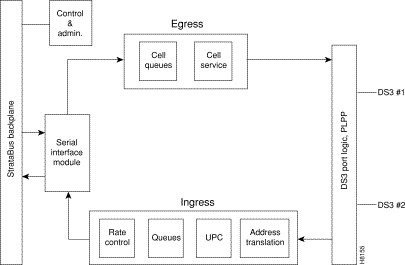
Each port provides an aggregate ATM connection bandwidth of 96,000 cells/second (T3) or 80,000 cells/sec (E3), or 353,208 cells/sec (OC3).
Connections are added using the addcon command.
Some of the functions performed by the PLPP in the ASI-1 include:
Connections are routed using the VPI and VCI address fields in the UNI header. The allowable range for VPI is from 0 to 255 (UNI) and 0 to 1023 (NNI), while VCI can range from 1 to 65535. A total of 1000 combinations of these can be used per ASI card at any one time.
A total of 1000 logical connections (ungrouped) may be configured for the node at any one time. On the BPX, 5000 grouped connections can be configured. The ASI-1 supports 1000 connections per card.
Two connection addressing modes are supported. The user may enter a unique VPI/VCI address in which case the BPX functions as a virtual circuit switch. Or the user may enter only a VPI address in which case all circuits are switched to the same destination port and the BPX functions as a virtual path switch in this case.
There are sixteen egress queues per line (port), including CBR, VBR, and ABR. When a connection is added, the user selects either constant bit rate (CBR), variable bit rate (VBR), or available bit rate (ABR, which uses ForeSight). The CBR queue has higher priority. Queue depth is specified when configuring a line. Maximum depth that can be specified for any one queue is 11,000 cells. Total queue depth cannot exceed 22,000 cells.
Connections are routed between CPE connected to ASI ports (Figure 5-3). Before adding connections, an ASI line is upped with the upln command and configured with the cnfln command. Then the associated port is configured with the cnfport command and upped with the upport command. Following this, the ATM connections are added via the addcon command with the syntax: slot.port.vpi.vci. The example shows a connection between alpha 4.1.1.1 and gamma 6.1.1.1.
The slot number is the ASI card slot on the BPX. The port number is one of two ports on the ASI, the VPI is the virtual path identifier, and the VCI is the virtual circuit identifier. (The top two ports on the LM-2T3 card are used, the bottom one is not.)
The VPI and VCI fields have significance only to the local BPX, and are translated by tables in the BPX to route the connection. Connections are automatically routed by the AutoRoute feature once the connection endpoints are specified.
Connections can be either Virtual Path Connections (VPC) or Virtual Circuit Connections (VCC). Virtual Path Connections are identified by an * in the VCI field. Virtual Circuit Connections specify both the VPI and VCI fields. Refer to the Command Reference and System Manual for further information.
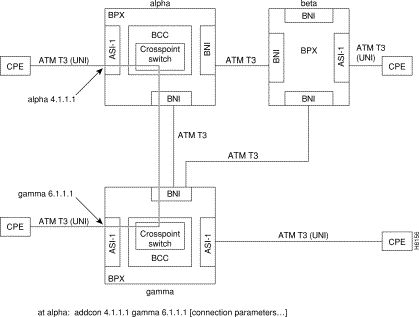
Port, line, and channel statistics are collected by the ASI-1. Refer to the StrataView Plus Operations Guide for a listing and description of these statistics.
The ASI front panel (Figure 5-4) has a three-section, multicolored "card" LED to indicate the card status. The card status LED is color-coded as indicated in Table 5-1. A two-section multicolored "port" LED indicates the status of the two ports on the ASI. The port status LED display is color-coded as indicated in Table 5-1
| Status | LED color | Status Description |
|---|---|---|
port | off | Line is inactive and not carrying data. |
| green | Line is actively carrying data. |
| yellow | Line is in remote alarm. |
| red | Line is in local alarm. |
card | green (act) | Card is on-line and one or more ports on the card have been upped. If off, card may be operational but is not carrying traffic. |
| yellow (stby) | Card is off-line and in standby mode (for redundant card pairs). May not have any upped ports. If blinking, indicates card firmware or configuration data is being updated. |
| red (fail) | Reserved for card failure. |

The T3 Line Module for the ASI-1 Front Card is a backcard used to provide a physical interface to the service interface (Figure 5-5). The Line Module connects to the ASI-1 through the StrataBus midplane. Two adjacent cards of the same type can be made redundant by using a Y-cable at the port connectors.
Except for using two ports instead of three, the LM-2T3 back card operates similarly to the BNI back cards, described previously.
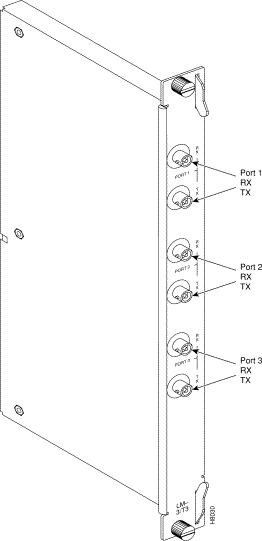
The E3 Line Module for the ASI-1 Front Card is a backcard used to provide a physical interface to the service interface (Figure 5-6). The Line Module connects to the ASI-1 through the StrataBus midplane. Two adjacent cards of the same type can be made redundant by using a Y-cable at the port connectors.
Except for using two ports instead of three, the LM-2E3 back card operates similarly to the BNI back cards, described previously.

The ATM Service Interface Card for OC3/STM-1, the ASI-155, is a BPX front card used to interface with an ATM user device e.g., CPE (Customer Premise Equipment). The ASI provides an industry-standard ATM User-to-Network Interface (UNI) or ATM Network-to-Network Interface (NNI) over OC3 lines to the BPX switching fabric.
There are three ASI-155 back cards, the LM-2OC3-SMF for single-mode fiber intermediate range, the LM-2OC3-SMFLR for single-mode fiber long range, and the LM-2OC3-MMF for multi-mode fiber. Any of the 12 general purpose slots can be used to hold these cards. These backcards may also be used with the BNI-155
A summary of features for the ASI-155 card include:
Connections are routed using the VPI and VCI address fields in the UNI header. The allowable range for VPI is from 0 to 255 (UNI) and 0 to 1023 (NNI), while VCI can range from 1 to 65535. A total of 1000 combinations of these can be used per ASI card at any one time. Future releases will support the full ATM address range.
There are two connection addressing modes supported. The user may enter a unique VPI/VCI address in which case the BPX functions as a virtual circuit switch. Or the user may enter only a VPI address in which case all circuits are switched to the same destination port and the BPX functions as a virtual path switch in this case.
There are 12 egress queues per line (port), two of which are used. These are for CBR, and VBR. When a connection is added, the user selects either a constant bit rate (CBR) or variable bit rate (VBR) connection class.
Connections are routed between CPE connected to ASI ports. Before adding connections, an ASI line is upped with the upln command and configured with the cnfln command. Then the associated port is configured with the cnfport command and upped with the upport command. Following this, the ATM connections are added via the addcon command with the syntax: slot.port.vpi.vci.
The slot number is the ASI card slot on the BPX. The port number is one of two ports on the ASI, the VPI is the virtual path identifier, and the VCI is the virtual circuit identifier.
The VPI and VCI fields have significance only to the local BPX, and are translated by tables in the BPX to route the connection. Connections are automatically routed by the AutoRoute feature once the connection endpoints are specified.
Connections can be either Virtual Path Connections (VPC) or Virtual Circuit Connections (VCC). Virtual Path Connections are identified by an * in the VCI field. Virtual Circuit Connections specify both the VPI and VCI fields.
ATM to Frame Relay Network and Service Interworking connections to the ASI are also supported. In the case of Network Interworking, the user CPE must be aware of the interworking function and provide the appropriate protocol mapping.
Refer to the Command Reference Manual and System Manual for further information.
For ingress traffic, the ATM Layer Interface (ALI) provides traffic management and admission controls (UPC) for the ASI-155 (Figure 5-7). The ASI-155 supports CBR and VBR connections and employs a single leaky bucket GCRA mechanism for policing cell streams seeking entrance to the network. Each PVC (VPC.VCC) is policed separately, providing firewalling between connections, and assuring that each connection uses only a fair share of network bandwidth. The ALI also performs ingress OAM functions.
The single leaky bucket policing function is implemented using a GCRA (Generic Rate Algorithm) defined by two parameters:
In the ingress direction, the ASI-155 has 2 Cell Input Engines (CIEs) that convert the incoming cell headers to the appropriate connection ID based on input from a Network Address Table.
For egress traffic, the Supervisory Cell Filter (SCF) provides routing and direction of non-data cells, such as test cells and OAM cells.
The Serial Interface Unit (SIU) provides the ASI with an 800 Mbps cell interface to the StrataBus. It provides serial-to-parallel conversion of data, along with loopback and test signal generation capabilities.
The Line Interface Unit (LIU) performs the following ingress functions:
The Line Interface Unit (LIU) performs the following egress functions:

Port, line, and channel statistics are collected by the ASI-155. The StrataView Plus workstation is used to collect and monitor these statistics. For additional information regarding ASI-155 statistics refer to the StrataView Plus Operations Guide.
The ASI-155 front panel (Figure 5-8) has a three-section, multicolored "card" LED to indicate the card status. The card status LED is color-coded as indicated in Table 5-2. A two-section multicolored "port" LED indicates the status of the two ports on the ASI-155. The port status LED display is color-coded as indicated in Table 5-2.
| Status | LED color | Status Description |
|---|---|---|
port | off | Line is inactive and not carrying data. |
| green | Line is actively carrying data. |
| yellow | Line is in remote alarm. |
| red | Line is in local alarm. |
card | green (act) | Card is on-line and one or more ports on the card have been upped. If off, card may be operational but is not carrying traffic. |
| yellow (stby) | Card is off-line and in standby mode (for redundant card pairs). May not have any upped ports. If blinking, indicates card firmware or configuration data is being updated. |
| red (fail) | Reserved for card failure. |
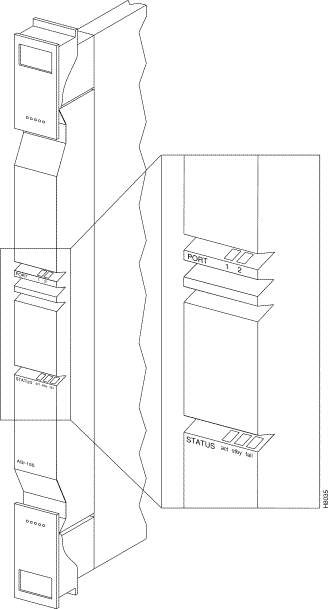
The LM- 2OC3 -SMF (Model SMF-2-BC) line module for the ASI-155 Front Card is a backcard that provides a SMF intermediate range service interface (Figure 4-8). The line module connects to the ASI-155 through the StrataBus midplane. Two adjacent cards of the same type can be made redundant by using a Y-cable at the port connectors. This is the same LM-2OC3-SMF backcard that is used for the BNI-155.
The LM- 2OC3 -SMFLR (Model SMFLR-2-BC) line module for the ASI-155 Front Card is a backcard that provides a SMF long range service interface. The line module connects to the ASI-155 through the StrataBus midplane. This is the same LM-2OC3-SMFLR backcard that is used for the BNI-155.
The LM-2OC3 -MMF (Model MMF-2-BC) line module for the ASI-155 Front Card is a backcard that provides a MMF service interface (Figure 4-9). The line module connects to the ASI-155 through the StrataBus midplane. This is the same LM-2OC3-SMF backcard that is used for the BNI-155.
The LM-OC3-SMF (Model SMF-2-BC) backcards may be Y-cabled for redundancy using the Y-Cable splitter (Model SMFY) shown in Figure 4-10. The cards must be configured for Y-Cable redundancy using the addyred command
The BXM card sets support OC-12c/STM-4 or OC-3C/STM-1 interfaces, and provide the capacity to meet the needs of emerging bandwidth driven applications. The BXM provides high speed ATM connectivity, flexibility, and scalability. The card sets are comprised of a front card that provides the processing, management, and switching of ATM traffic and of a back card that provides the physical interface for the card set.
A BXM port may be configured to operate as either a trunk or UNI port. The BXM OC-12 back cards support either Single Mode Fiber (SMF) or Single Mode Fiber Long Reach (SMFLR). The BXM OC-3 back cards support either Multi-Mode Fiber (MMF), Single Mode Fiber (SMF), or Single Mode Fiber Long Reach (SMFLR).
For a further description of the BXM cards refer to, Chapter 6, BXM T3/E3, 155, and 622.
At least one node in the network (or network domain if a structured network) must include a Strata-View Plus network management station (Figure 5-9). A Y-cable may used to connect the LAN ports on the primary and secondary BCC Line Modules, through an AUI to the LAN network, as only one BCC is active at a time. The serial Control port may be connected to a dial-in modem for remote service support or other dial-up network management access. The serial Auxiliary port is used for outgoing data only, for example, for connection to a printer.
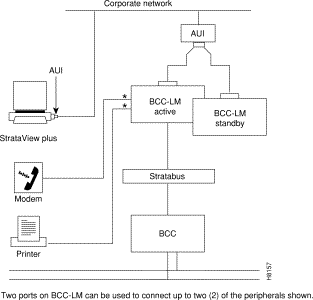
![]()
![]()
![]()
![]()
![]()
![]()
![]()
![]()
Posted: Wed Jan 17 21:17:32 PST 2001
All contents are Copyright © 1992--2001 Cisco Systems, Inc. All rights reserved.
Important Notices and Privacy Statement.